Analysis of Intercultural Competence in Business: MAR013-1 Report
VerifiedAdded on 2022/12/26
|8
|2281
|77
Report
AI Summary
This report delves into the concept of intercultural competence within a business context, addressing the challenges of cross-cultural communication through a case study involving a US airline manager setting up an office in Saudi Arabia. It explores the problems arising from cultural differences and applies relevant intercultural theories, including Hofstede's cultural dimensions, to analyze the situation. The report provides practical advice for the manager, Stefan, on how to navigate these challenges, improve communication, and foster a more effective and understanding work environment. It emphasizes the importance of understanding cultural nuances, utilizing intercultural communication theories, and implementing training programs to bridge cultural gaps and enhance business outcomes. The report concludes by highlighting the significance of intercultural competence in achieving business success in a globalized world.
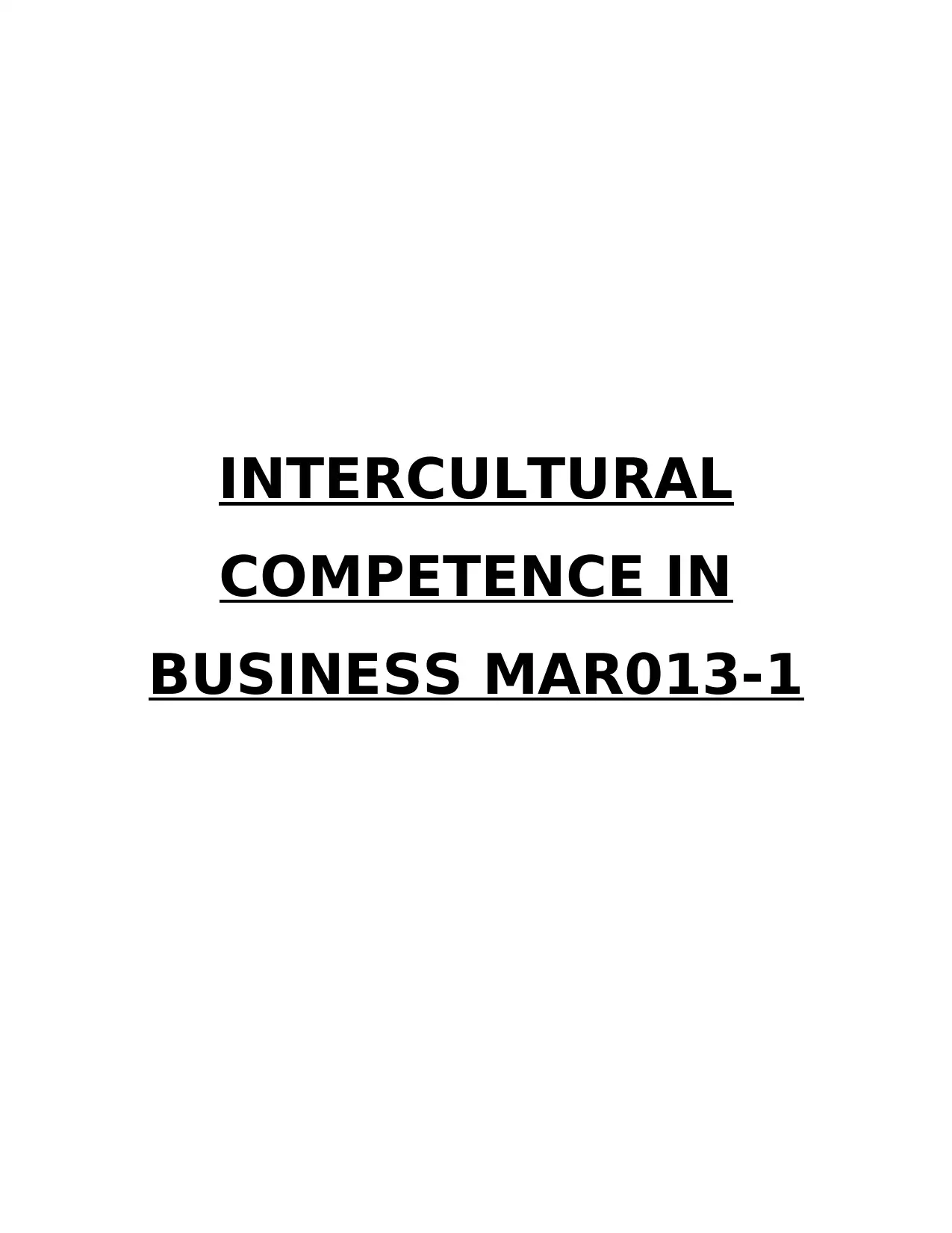
INTERCULTURAL
COMPETENCE IN
BUSINESS MAR013-1
COMPETENCE IN
BUSINESS MAR013-1
Paraphrase This Document
Need a fresh take? Get an instant paraphrase of this document with our AI Paraphraser
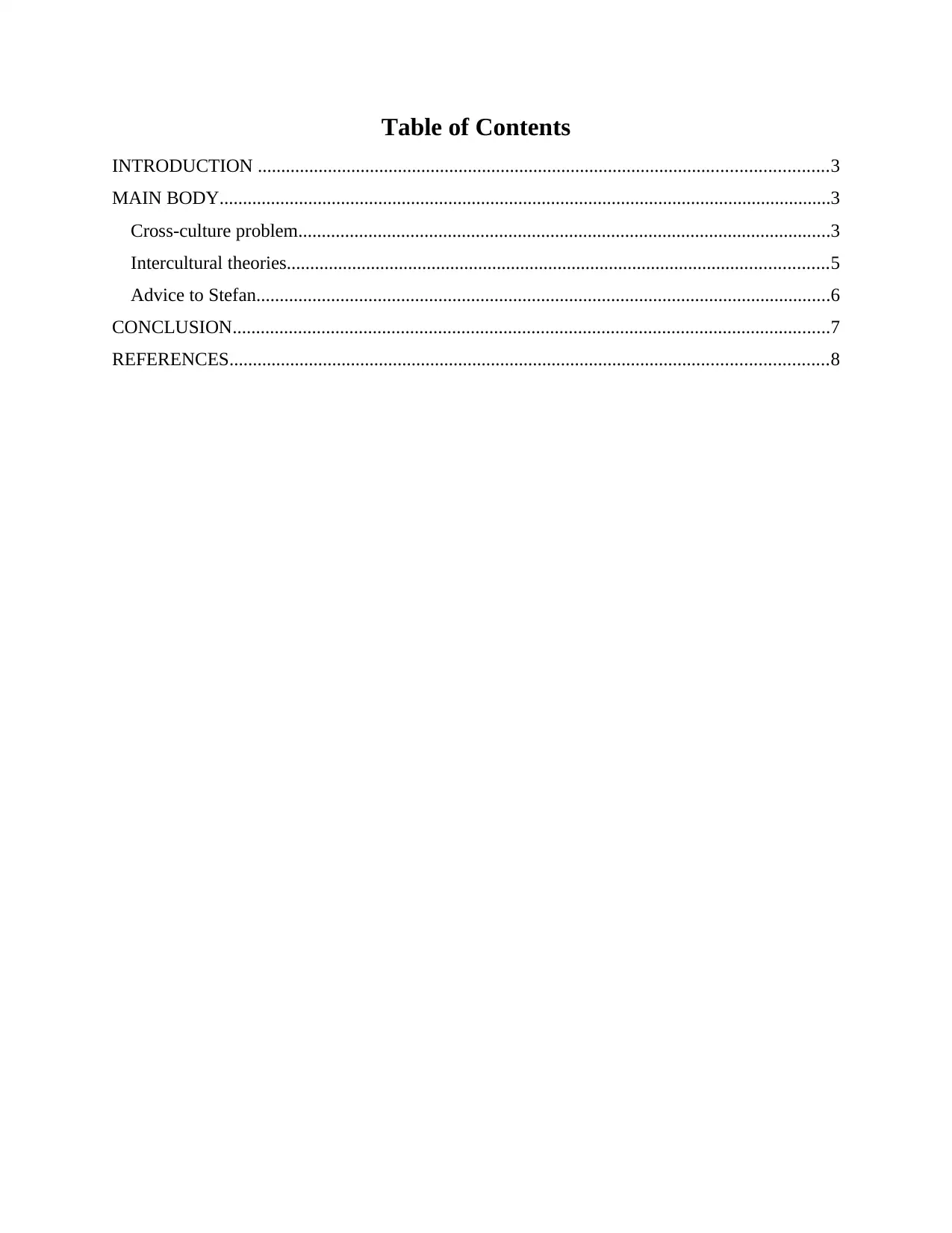
Table of Contents
INTRODUCTION ..........................................................................................................................3
MAIN BODY...................................................................................................................................3
Cross-culture problem..................................................................................................................3
Intercultural theories....................................................................................................................5
Advice to Stefan...........................................................................................................................6
CONCLUSION................................................................................................................................7
REFERENCES................................................................................................................................8
INTRODUCTION ..........................................................................................................................3
MAIN BODY...................................................................................................................................3
Cross-culture problem..................................................................................................................3
Intercultural theories....................................................................................................................5
Advice to Stefan...........................................................................................................................6
CONCLUSION................................................................................................................................7
REFERENCES................................................................................................................................8
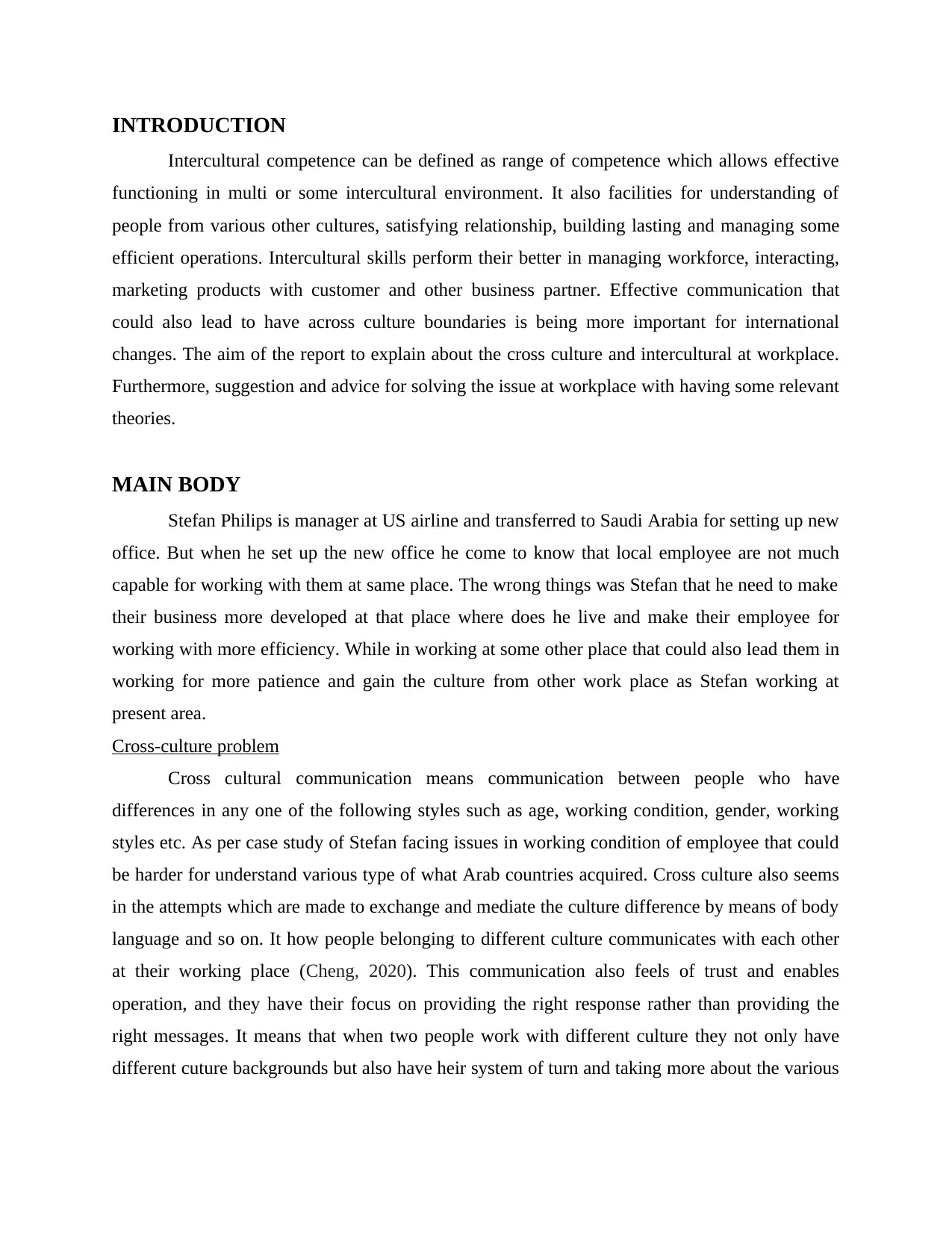
INTRODUCTION
Intercultural competence can be defined as range of competence which allows effective
functioning in multi or some intercultural environment. It also facilities for understanding of
people from various other cultures, satisfying relationship, building lasting and managing some
efficient operations. Intercultural skills perform their better in managing workforce, interacting,
marketing products with customer and other business partner. Effective communication that
could also lead to have across culture boundaries is being more important for international
changes. The aim of the report to explain about the cross culture and intercultural at workplace.
Furthermore, suggestion and advice for solving the issue at workplace with having some relevant
theories.
MAIN BODY
Stefan Philips is manager at US airline and transferred to Saudi Arabia for setting up new
office. But when he set up the new office he come to know that local employee are not much
capable for working with them at same place. The wrong things was Stefan that he need to make
their business more developed at that place where does he live and make their employee for
working with more efficiency. While in working at some other place that could also lead them in
working for more patience and gain the culture from other work place as Stefan working at
present area.
Cross-culture problem
Cross cultural communication means communication between people who have
differences in any one of the following styles such as age, working condition, gender, working
styles etc. As per case study of Stefan facing issues in working condition of employee that could
be harder for understand various type of what Arab countries acquired. Cross culture also seems
in the attempts which are made to exchange and mediate the culture difference by means of body
language and so on. It how people belonging to different culture communicates with each other
at their working place (Cheng, 2020). This communication also feels of trust and enables
operation, and they have their focus on providing the right response rather than providing the
right messages. It means that when two people work with different culture they not only have
different cuture backgrounds but also have heir system of turn and taking more about the various
Intercultural competence can be defined as range of competence which allows effective
functioning in multi or some intercultural environment. It also facilities for understanding of
people from various other cultures, satisfying relationship, building lasting and managing some
efficient operations. Intercultural skills perform their better in managing workforce, interacting,
marketing products with customer and other business partner. Effective communication that
could also lead to have across culture boundaries is being more important for international
changes. The aim of the report to explain about the cross culture and intercultural at workplace.
Furthermore, suggestion and advice for solving the issue at workplace with having some relevant
theories.
MAIN BODY
Stefan Philips is manager at US airline and transferred to Saudi Arabia for setting up new
office. But when he set up the new office he come to know that local employee are not much
capable for working with them at same place. The wrong things was Stefan that he need to make
their business more developed at that place where does he live and make their employee for
working with more efficiency. While in working at some other place that could also lead them in
working for more patience and gain the culture from other work place as Stefan working at
present area.
Cross-culture problem
Cross cultural communication means communication between people who have
differences in any one of the following styles such as age, working condition, gender, working
styles etc. As per case study of Stefan facing issues in working condition of employee that could
be harder for understand various type of what Arab countries acquired. Cross culture also seems
in the attempts which are made to exchange and mediate the culture difference by means of body
language and so on. It how people belonging to different culture communicates with each other
at their working place (Cheng, 2020). This communication also feels of trust and enables
operation, and they have their focus on providing the right response rather than providing the
right messages. It means that when two people work with different culture they not only have
different cuture backgrounds but also have heir system of turn and taking more about the various
⊘ This is a preview!⊘
Do you want full access?
Subscribe today to unlock all pages.

Trusted by 1+ million students worldwide
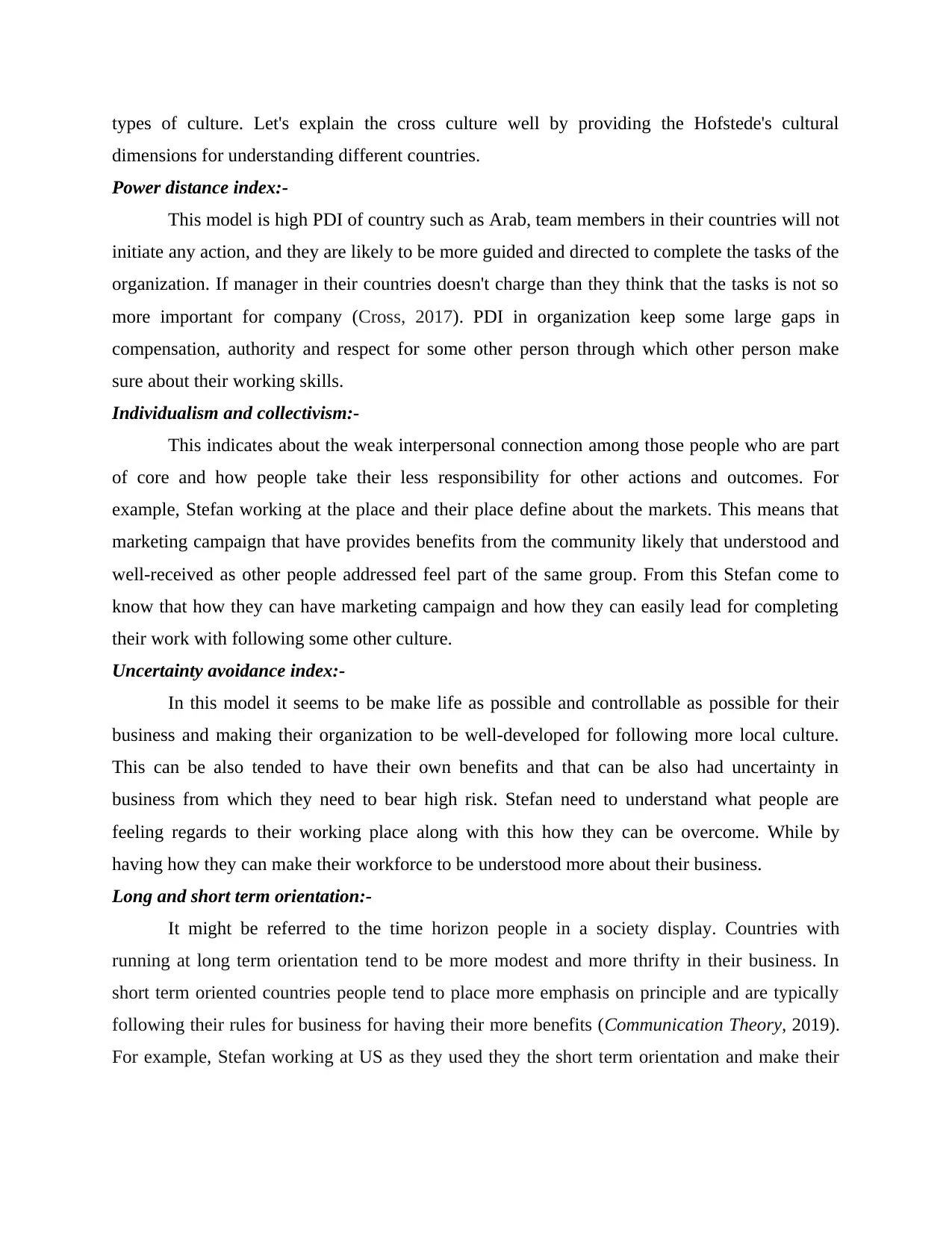
types of culture. Let's explain the cross culture well by providing the Hofstede's cultural
dimensions for understanding different countries.
Power distance index:-
This model is high PDI of country such as Arab, team members in their countries will not
initiate any action, and they are likely to be more guided and directed to complete the tasks of the
organization. If manager in their countries doesn't charge than they think that the tasks is not so
more important for company (Cross, 2017). PDI in organization keep some large gaps in
compensation, authority and respect for some other person through which other person make
sure about their working skills.
Individualism and collectivism:-
This indicates about the weak interpersonal connection among those people who are part
of core and how people take their less responsibility for other actions and outcomes. For
example, Stefan working at the place and their place define about the markets. This means that
marketing campaign that have provides benefits from the community likely that understood and
well-received as other people addressed feel part of the same group. From this Stefan come to
know that how they can have marketing campaign and how they can easily lead for completing
their work with following some other culture.
Uncertainty avoidance index:-
In this model it seems to be make life as possible and controllable as possible for their
business and making their organization to be well-developed for following more local culture.
This can be also tended to have their own benefits and that can be also had uncertainty in
business from which they need to bear high risk. Stefan need to understand what people are
feeling regards to their working place along with this how they can be overcome. While by
having how they can make their workforce to be understood more about their business.
Long and short term orientation:-
It might be referred to the time horizon people in a society display. Countries with
running at long term orientation tend to be more modest and more thrifty in their business. In
short term oriented countries people tend to place more emphasis on principle and are typically
following their rules for business for having their more benefits (Communication Theory, 2019).
For example, Stefan working at US as they used they the short term orientation and make their
dimensions for understanding different countries.
Power distance index:-
This model is high PDI of country such as Arab, team members in their countries will not
initiate any action, and they are likely to be more guided and directed to complete the tasks of the
organization. If manager in their countries doesn't charge than they think that the tasks is not so
more important for company (Cross, 2017). PDI in organization keep some large gaps in
compensation, authority and respect for some other person through which other person make
sure about their working skills.
Individualism and collectivism:-
This indicates about the weak interpersonal connection among those people who are part
of core and how people take their less responsibility for other actions and outcomes. For
example, Stefan working at the place and their place define about the markets. This means that
marketing campaign that have provides benefits from the community likely that understood and
well-received as other people addressed feel part of the same group. From this Stefan come to
know that how they can have marketing campaign and how they can easily lead for completing
their work with following some other culture.
Uncertainty avoidance index:-
In this model it seems to be make life as possible and controllable as possible for their
business and making their organization to be well-developed for following more local culture.
This can be also tended to have their own benefits and that can be also had uncertainty in
business from which they need to bear high risk. Stefan need to understand what people are
feeling regards to their working place along with this how they can be overcome. While by
having how they can make their workforce to be understood more about their business.
Long and short term orientation:-
It might be referred to the time horizon people in a society display. Countries with
running at long term orientation tend to be more modest and more thrifty in their business. In
short term oriented countries people tend to place more emphasis on principle and are typically
following their rules for business for having their more benefits (Communication Theory, 2019).
For example, Stefan working at US as they used they the short term orientation and make their
Paraphrase This Document
Need a fresh take? Get an instant paraphrase of this document with our AI Paraphraser
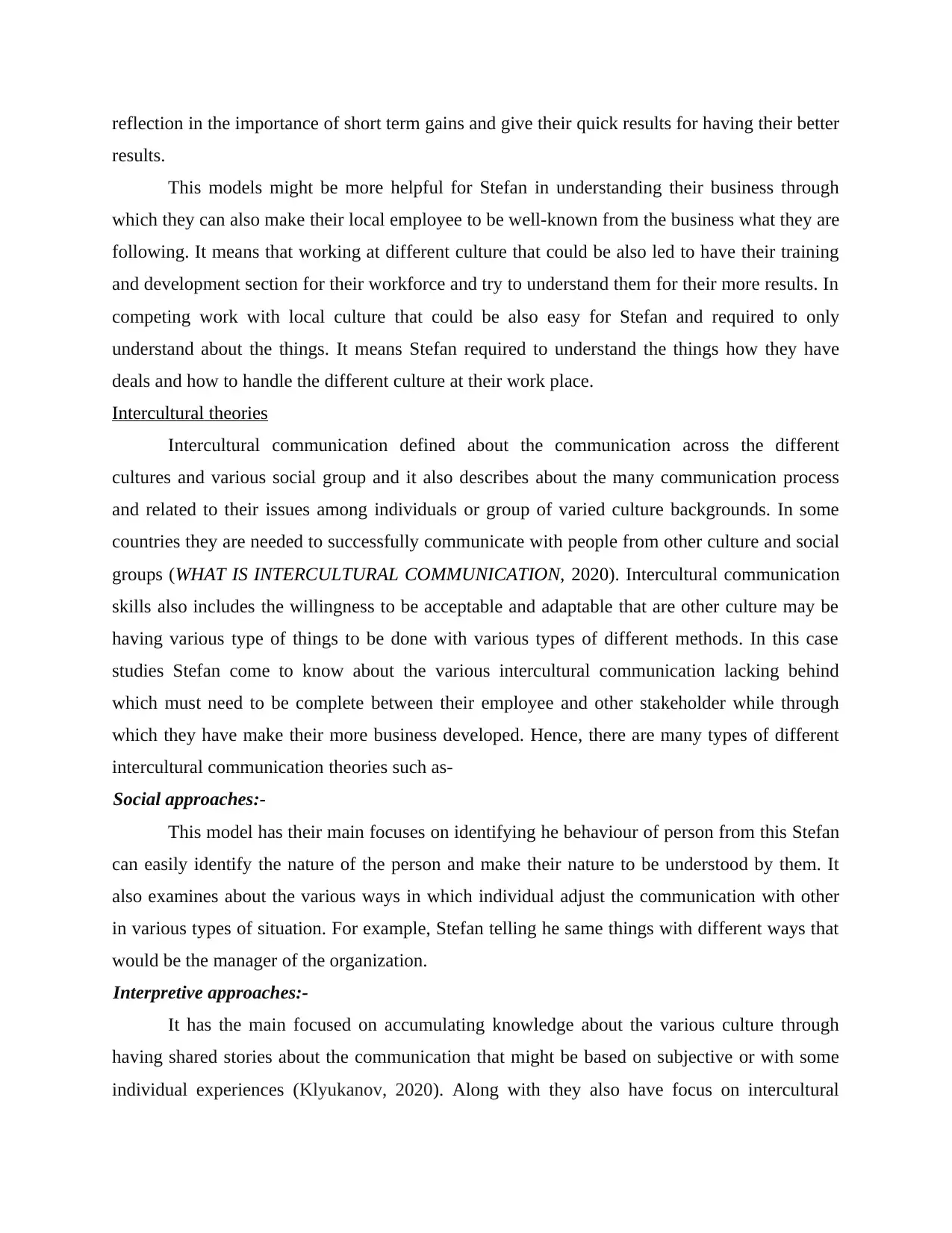
reflection in the importance of short term gains and give their quick results for having their better
results.
This models might be more helpful for Stefan in understanding their business through
which they can also make their local employee to be well-known from the business what they are
following. It means that working at different culture that could be also led to have their training
and development section for their workforce and try to understand them for their more results. In
competing work with local culture that could be also easy for Stefan and required to only
understand about the things. It means Stefan required to understand the things how they have
deals and how to handle the different culture at their work place.
Intercultural theories
Intercultural communication defined about the communication across the different
cultures and various social group and it also describes about the many communication process
and related to their issues among individuals or group of varied culture backgrounds. In some
countries they are needed to successfully communicate with people from other culture and social
groups (WHAT IS INTERCULTURAL COMMUNICATION, 2020). Intercultural communication
skills also includes the willingness to be acceptable and adaptable that are other culture may be
having various type of things to be done with various types of different methods. In this case
studies Stefan come to know about the various intercultural communication lacking behind
which must need to be complete between their employee and other stakeholder while through
which they have make their more business developed. Hence, there are many types of different
intercultural communication theories such as-
Social approaches:-
This model has their main focuses on identifying he behaviour of person from this Stefan
can easily identify the nature of the person and make their nature to be understood by them. It
also examines about the various ways in which individual adjust the communication with other
in various types of situation. For example, Stefan telling he same things with different ways that
would be the manager of the organization.
Interpretive approaches:-
It has the main focused on accumulating knowledge about the various culture through
having shared stories about the communication that might be based on subjective or with some
individual experiences (Klyukanov, 2020). Along with they also have focus on intercultural
results.
This models might be more helpful for Stefan in understanding their business through
which they can also make their local employee to be well-known from the business what they are
following. It means that working at different culture that could be also led to have their training
and development section for their workforce and try to understand them for their more results. In
competing work with local culture that could be also easy for Stefan and required to only
understand about the things. It means Stefan required to understand the things how they have
deals and how to handle the different culture at their work place.
Intercultural theories
Intercultural communication defined about the communication across the different
cultures and various social group and it also describes about the many communication process
and related to their issues among individuals or group of varied culture backgrounds. In some
countries they are needed to successfully communicate with people from other culture and social
groups (WHAT IS INTERCULTURAL COMMUNICATION, 2020). Intercultural communication
skills also includes the willingness to be acceptable and adaptable that are other culture may be
having various type of things to be done with various types of different methods. In this case
studies Stefan come to know about the various intercultural communication lacking behind
which must need to be complete between their employee and other stakeholder while through
which they have make their more business developed. Hence, there are many types of different
intercultural communication theories such as-
Social approaches:-
This model has their main focuses on identifying he behaviour of person from this Stefan
can easily identify the nature of the person and make their nature to be understood by them. It
also examines about the various ways in which individual adjust the communication with other
in various types of situation. For example, Stefan telling he same things with different ways that
would be the manager of the organization.
Interpretive approaches:-
It has the main focused on accumulating knowledge about the various culture through
having shared stories about the communication that might be based on subjective or with some
individual experiences (Klyukanov, 2020). Along with they also have focus on intercultural
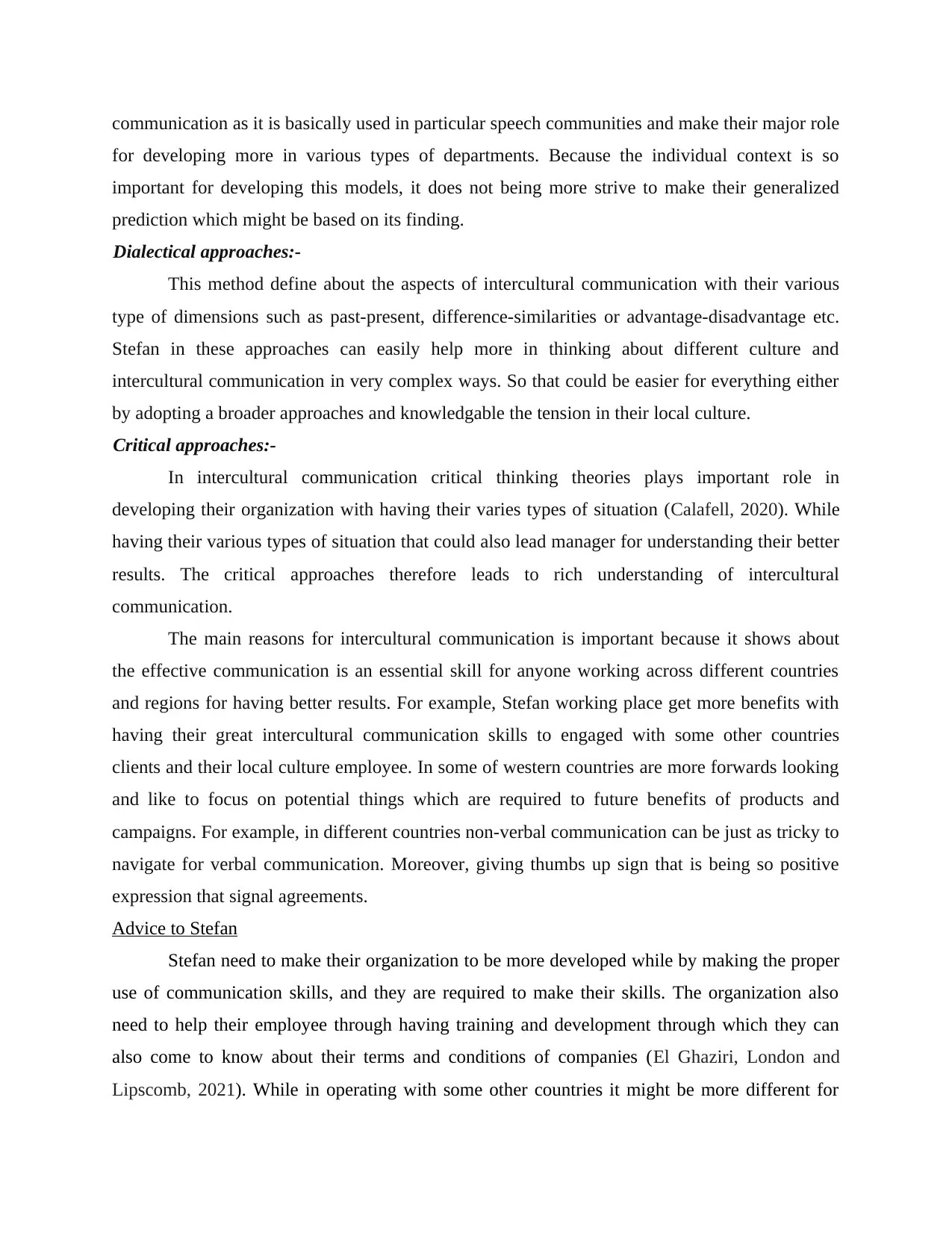
communication as it is basically used in particular speech communities and make their major role
for developing more in various types of departments. Because the individual context is so
important for developing this models, it does not being more strive to make their generalized
prediction which might be based on its finding.
Dialectical approaches:-
This method define about the aspects of intercultural communication with their various
type of dimensions such as past-present, difference-similarities or advantage-disadvantage etc.
Stefan in these approaches can easily help more in thinking about different culture and
intercultural communication in very complex ways. So that could be easier for everything either
by adopting a broader approaches and knowledgable the tension in their local culture.
Critical approaches:-
In intercultural communication critical thinking theories plays important role in
developing their organization with having their varies types of situation (Calafell, 2020). While
having their various types of situation that could also lead manager for understanding their better
results. The critical approaches therefore leads to rich understanding of intercultural
communication.
The main reasons for intercultural communication is important because it shows about
the effective communication is an essential skill for anyone working across different countries
and regions for having better results. For example, Stefan working place get more benefits with
having their great intercultural communication skills to engaged with some other countries
clients and their local culture employee. In some of western countries are more forwards looking
and like to focus on potential things which are required to future benefits of products and
campaigns. For example, in different countries non-verbal communication can be just as tricky to
navigate for verbal communication. Moreover, giving thumbs up sign that is being so positive
expression that signal agreements.
Advice to Stefan
Stefan need to make their organization to be more developed while by making the proper
use of communication skills, and they are required to make their skills. The organization also
need to help their employee through having training and development through which they can
also come to know about their terms and conditions of companies (El Ghaziri, London and
Lipscomb, 2021). While in operating with some other countries it might be more different for
for developing more in various types of departments. Because the individual context is so
important for developing this models, it does not being more strive to make their generalized
prediction which might be based on its finding.
Dialectical approaches:-
This method define about the aspects of intercultural communication with their various
type of dimensions such as past-present, difference-similarities or advantage-disadvantage etc.
Stefan in these approaches can easily help more in thinking about different culture and
intercultural communication in very complex ways. So that could be easier for everything either
by adopting a broader approaches and knowledgable the tension in their local culture.
Critical approaches:-
In intercultural communication critical thinking theories plays important role in
developing their organization with having their varies types of situation (Calafell, 2020). While
having their various types of situation that could also lead manager for understanding their better
results. The critical approaches therefore leads to rich understanding of intercultural
communication.
The main reasons for intercultural communication is important because it shows about
the effective communication is an essential skill for anyone working across different countries
and regions for having better results. For example, Stefan working place get more benefits with
having their great intercultural communication skills to engaged with some other countries
clients and their local culture employee. In some of western countries are more forwards looking
and like to focus on potential things which are required to future benefits of products and
campaigns. For example, in different countries non-verbal communication can be just as tricky to
navigate for verbal communication. Moreover, giving thumbs up sign that is being so positive
expression that signal agreements.
Advice to Stefan
Stefan need to make their organization to be more developed while by making the proper
use of communication skills, and they are required to make their skills. The organization also
need to help their employee through having training and development through which they can
also come to know about their terms and conditions of companies (El Ghaziri, London and
Lipscomb, 2021). While in operating with some other countries it might be more different for
⊘ This is a preview!⊘
Do you want full access?
Subscribe today to unlock all pages.

Trusted by 1+ million students worldwide
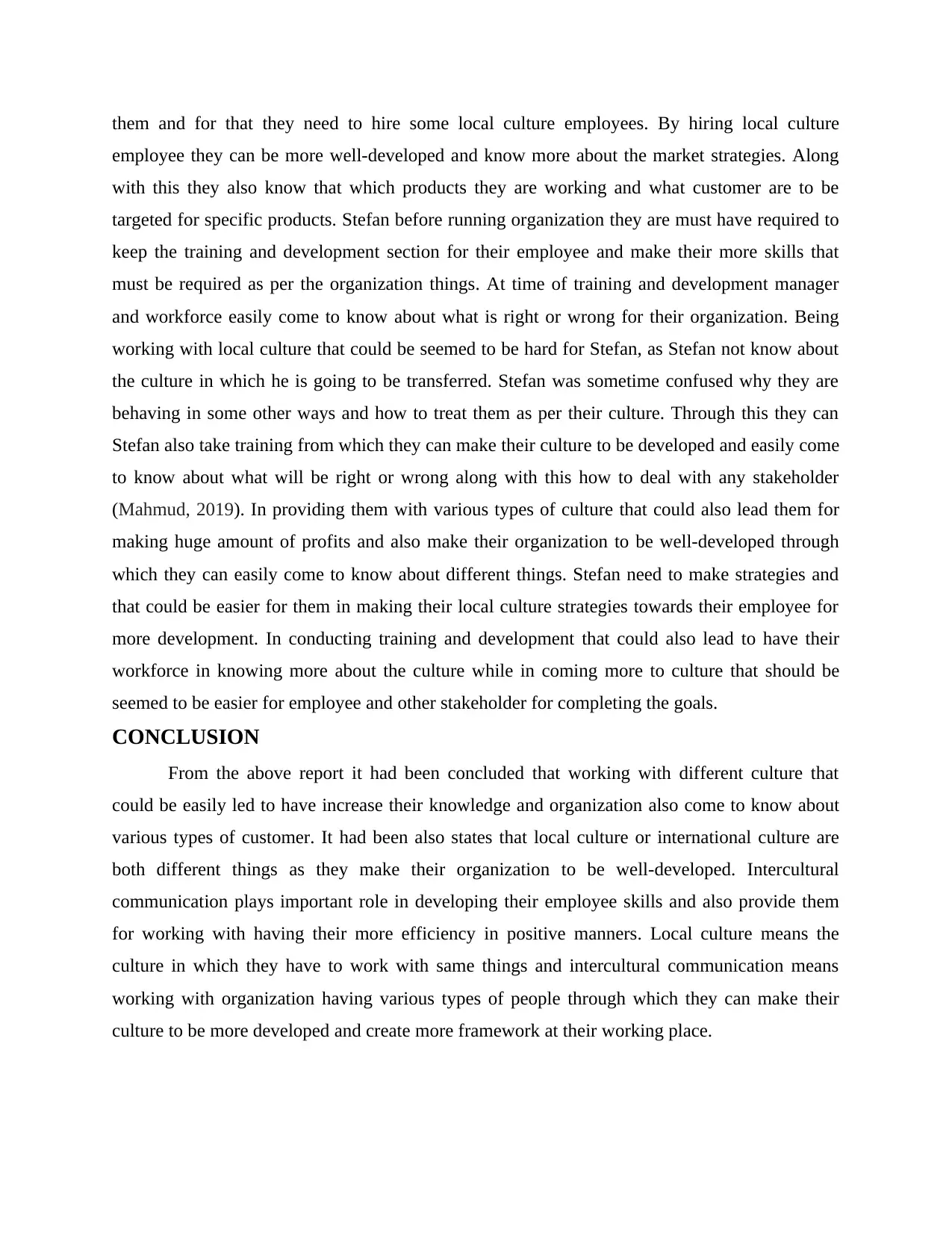
them and for that they need to hire some local culture employees. By hiring local culture
employee they can be more well-developed and know more about the market strategies. Along
with this they also know that which products they are working and what customer are to be
targeted for specific products. Stefan before running organization they are must have required to
keep the training and development section for their employee and make their more skills that
must be required as per the organization things. At time of training and development manager
and workforce easily come to know about what is right or wrong for their organization. Being
working with local culture that could be seemed to be hard for Stefan, as Stefan not know about
the culture in which he is going to be transferred. Stefan was sometime confused why they are
behaving in some other ways and how to treat them as per their culture. Through this they can
Stefan also take training from which they can make their culture to be developed and easily come
to know about what will be right or wrong along with this how to deal with any stakeholder
(Mahmud, 2019). In providing them with various types of culture that could also lead them for
making huge amount of profits and also make their organization to be well-developed through
which they can easily come to know about different things. Stefan need to make strategies and
that could be easier for them in making their local culture strategies towards their employee for
more development. In conducting training and development that could also lead to have their
workforce in knowing more about the culture while in coming more to culture that should be
seemed to be easier for employee and other stakeholder for completing the goals.
CONCLUSION
From the above report it had been concluded that working with different culture that
could be easily led to have increase their knowledge and organization also come to know about
various types of customer. It had been also states that local culture or international culture are
both different things as they make their organization to be well-developed. Intercultural
communication plays important role in developing their employee skills and also provide them
for working with having their more efficiency in positive manners. Local culture means the
culture in which they have to work with same things and intercultural communication means
working with organization having various types of people through which they can make their
culture to be more developed and create more framework at their working place.
employee they can be more well-developed and know more about the market strategies. Along
with this they also know that which products they are working and what customer are to be
targeted for specific products. Stefan before running organization they are must have required to
keep the training and development section for their employee and make their more skills that
must be required as per the organization things. At time of training and development manager
and workforce easily come to know about what is right or wrong for their organization. Being
working with local culture that could be seemed to be hard for Stefan, as Stefan not know about
the culture in which he is going to be transferred. Stefan was sometime confused why they are
behaving in some other ways and how to treat them as per their culture. Through this they can
Stefan also take training from which they can make their culture to be developed and easily come
to know about what will be right or wrong along with this how to deal with any stakeholder
(Mahmud, 2019). In providing them with various types of culture that could also lead them for
making huge amount of profits and also make their organization to be well-developed through
which they can easily come to know about different things. Stefan need to make strategies and
that could be easier for them in making their local culture strategies towards their employee for
more development. In conducting training and development that could also lead to have their
workforce in knowing more about the culture while in coming more to culture that should be
seemed to be easier for employee and other stakeholder for completing the goals.
CONCLUSION
From the above report it had been concluded that working with different culture that
could be easily led to have increase their knowledge and organization also come to know about
various types of customer. It had been also states that local culture or international culture are
both different things as they make their organization to be well-developed. Intercultural
communication plays important role in developing their employee skills and also provide them
for working with having their more efficiency in positive manners. Local culture means the
culture in which they have to work with same things and intercultural communication means
working with organization having various types of people through which they can make their
culture to be more developed and create more framework at their working place.
Paraphrase This Document
Need a fresh take? Get an instant paraphrase of this document with our AI Paraphraser
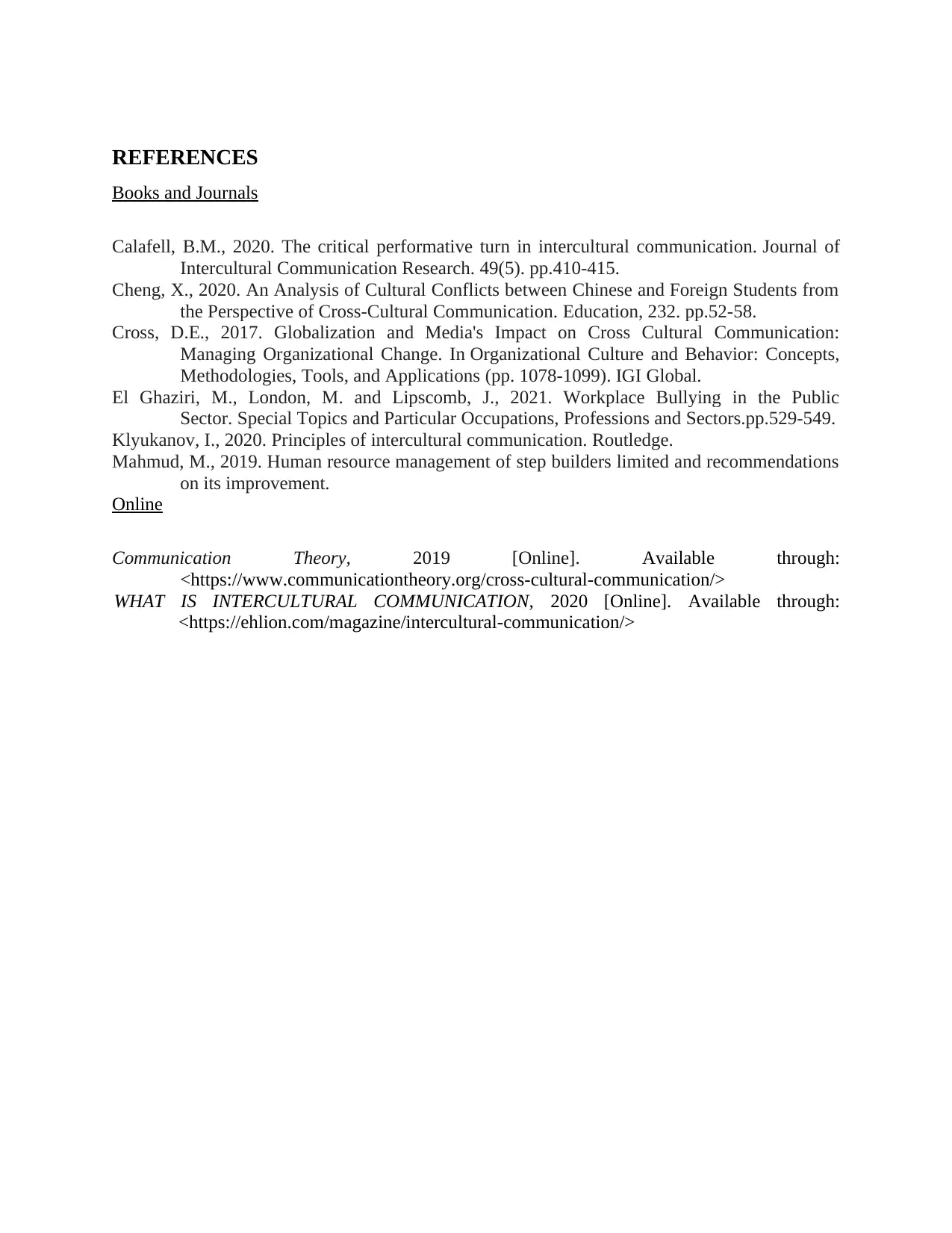
REFERENCES
Books and Journals
Calafell, B.M., 2020. The critical performative turn in intercultural communication. Journal of
Intercultural Communication Research. 49(5). pp.410-415.
Cheng, X., 2020. An Analysis of Cultural Conflicts between Chinese and Foreign Students from
the Perspective of Cross-Cultural Communication. Education, 232. pp.52-58.
Cross, D.E., 2017. Globalization and Media's Impact on Cross Cultural Communication:
Managing Organizational Change. In Organizational Culture and Behavior: Concepts,
Methodologies, Tools, and Applications (pp. 1078-1099). IGI Global.
El Ghaziri, M., London, M. and Lipscomb, J., 2021. Workplace Bullying in the Public
Sector. Special Topics and Particular Occupations, Professions and Sectors.pp.529-549.
Klyukanov, I., 2020. Principles of intercultural communication. Routledge.
Mahmud, M., 2019. Human resource management of step builders limited and recommendations
on its improvement.
Online
Communication Theory, 2019 [Online]. Available through:
<https://www.communicationtheory.org/cross-cultural-communication/>
WHAT IS INTERCULTURAL COMMUNICATION, 2020 [Online]. Available through:
<https://ehlion.com/magazine/intercultural-communication/>
Books and Journals
Calafell, B.M., 2020. The critical performative turn in intercultural communication. Journal of
Intercultural Communication Research. 49(5). pp.410-415.
Cheng, X., 2020. An Analysis of Cultural Conflicts between Chinese and Foreign Students from
the Perspective of Cross-Cultural Communication. Education, 232. pp.52-58.
Cross, D.E., 2017. Globalization and Media's Impact on Cross Cultural Communication:
Managing Organizational Change. In Organizational Culture and Behavior: Concepts,
Methodologies, Tools, and Applications (pp. 1078-1099). IGI Global.
El Ghaziri, M., London, M. and Lipscomb, J., 2021. Workplace Bullying in the Public
Sector. Special Topics and Particular Occupations, Professions and Sectors.pp.529-549.
Klyukanov, I., 2020. Principles of intercultural communication. Routledge.
Mahmud, M., 2019. Human resource management of step builders limited and recommendations
on its improvement.
Online
Communication Theory, 2019 [Online]. Available through:
<https://www.communicationtheory.org/cross-cultural-communication/>
WHAT IS INTERCULTURAL COMMUNICATION, 2020 [Online]. Available through:
<https://ehlion.com/magazine/intercultural-communication/>
1 out of 8
Related Documents
Your All-in-One AI-Powered Toolkit for Academic Success.
+13062052269
info@desklib.com
Available 24*7 on WhatsApp / Email
![[object Object]](/_next/static/media/star-bottom.7253800d.svg)
Unlock your academic potential
Copyright © 2020–2025 A2Z Services. All Rights Reserved. Developed and managed by ZUCOL.




